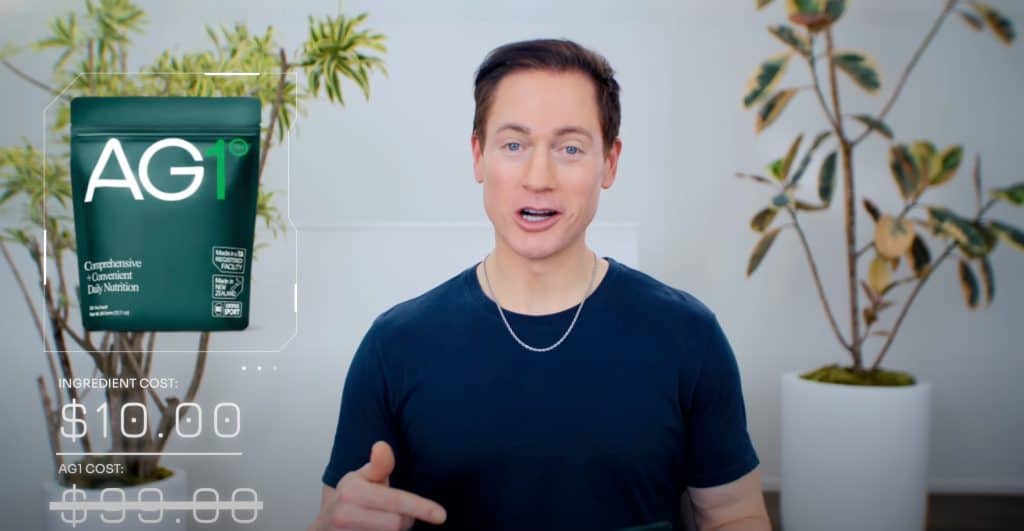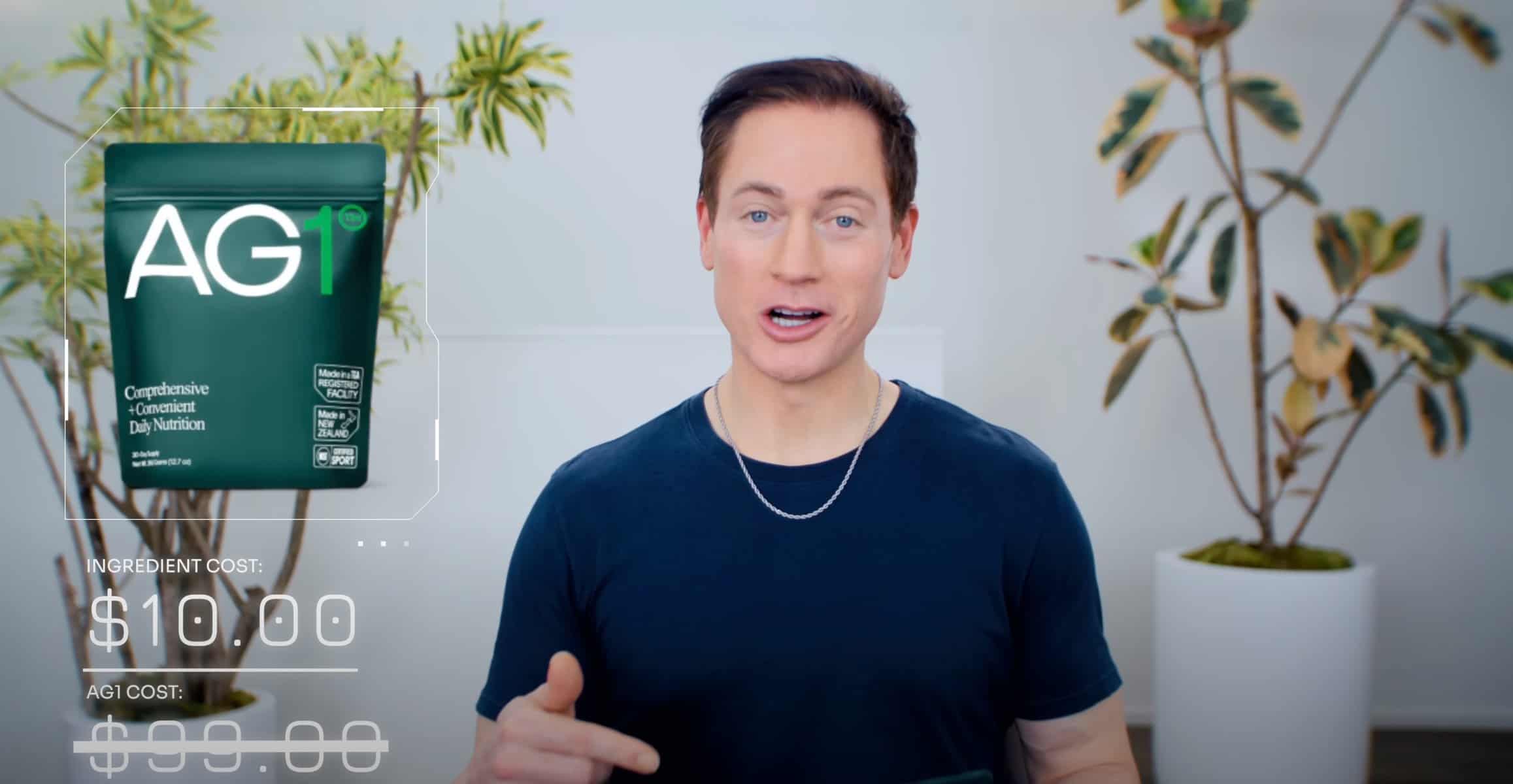In the world of health and wellness, products that promise to revolutionize your diet and lifestyle seem to appear every day. One such product, AG1 (formerly known as Athletic Greens), has taken the spotlight as a premium nutritional supplement. Widely endorsed by influencers, AG1 claims to offer a comprehensive solution to daily nutrition, packed with essential vitamins, minerals, and other ingredients that supposedly enhance health and well-being. However, according to Bryan Johnson, a health and wellness expert, AG1 may not be all it’s cracked up to be.
In a viral video titled “AG1 Failed. Here’s Why”, Johnson explains why AG1 falls short of expectations and why consumers should be wary of its claims. With over 600K views, Johnson’s analysis has resonated with many viewers, shining a spotlight on the significant issues surrounding this popular product. In this article, we’ll explore Johnson’s key criticisms of AG1, including its price, transparency, and marketing strategies, and offer insights into the broader implications for the health and wellness industry.

The AG1 Price Dilemma: Overpriced and Underperforming?
One of the most glaring issues with AG1, according to Bryan Johnson, is its price. AG1 is marketed as a premium product, selling for a hefty $99 per month for a single purchase. This price point positions it as a high-end, elite supplement aimed at people who are willing to invest in their health. However, Johnson argues that the actual cost of the ingredients is a mere fraction of that price. He claims that AG1’s ingredients only cost about $10, which means there is an enormous markup.
Johnson explains that after factoring in manufacturing and distribution costs, AG1 still maintains a considerable profit margin. The gap between the cost of production and the selling price raises questions about whether consumers are truly getting their money’s worth. With such a significant markup, Johnson argues that AG1 is not delivering the value that it promises. For a product that claims to be the best on the market, the disparity between its cost and price is hard to ignore.
Marketing Strategies: Influencer Endorsements and Recurring Profits
AG1 has become a household name, thanks in large part to its aggressive marketing campaigns. You’ve likely heard about AG1 from influencers, podcasts, or online ads. These influencers regularly tout the product’s benefits, often linking to discount codes and personalized referral links. While influencer marketing is nothing new, Johnson highlights a crucial point: AG1 pays influencers a commission ranging between 20% and 30% of every sale, not just for one-time purchases but on a recurring basis.
This means that every time a customer subscribes to AG1 through an influencer’s referral link, the influencer continues to earn a commission for as long as the subscription remains active. In his video, Johnson points out how this creates a significant incentive for influencers to push the product, even if they don’t fully believe in its benefits. He argues that it becomes difficult for consumers to trust these endorsements because influencers stand to make large sums of money—potentially hundreds of thousands of dollars per month—just by promoting AG1.
While influencer marketing is effective, it raises ethical concerns when influencers profit heavily from products that may not provide the benefits they claim. Johnson encourages viewers to “follow the money” to understand the real motivations behind these glowing endorsements.

Pixie Dusting: Insufficient Ingredient Dosages
Another significant criticism Johnson levels at AG1 is the practice of “pixie dusting.” This term refers to the inclusion of well-known ingredients in a product but in amounts too small to provide any real benefit. On AG1’s packaging, you’ll find a long list of ingredients that sound impressive—vitamins, minerals, probiotics, and superfoods—but many of these ingredients are included in minuscule amounts that aren’t effective.
Johnson explains that while some ingredients in AG1 have disclosed doses, 49 ingredients do not have any disclosed dosage information. This lack of transparency means that consumers have no idea how much of these ingredients they are actually consuming. For instance, while AG1 may list biotin as an ingredient, it’s included in a tiny amount (330 mcgs), which may not be enough to deliver the desired health benefits.
By sprinkling small amounts of popular ingredients, AG1 creates the illusion of a nutrient-packed product without actually providing the clinical dosages needed to make a difference. Johnson argues that this is misleading and unfair to consumers who trust the brand’s promises of optimal nutrition.
Transparency Matters: A Blueprint for Ethical Supplementation
In contrast to AG1’s questionable practices, Johnson offers a more transparent and ethical alternative—his own company, Blueprint. Johnson explains that he never intended to enter the supplement business, but after receiving requests from followers who wanted an easy way to replicate his nutritional regimen, he decided to create his own product line.
What sets Blueprint apart, according to Johnson, is its commitment to transparency and scientific rigor. Every ingredient is clearly listed with its exact dosage, and each product undergoes rigorous third-party testing. Johnson highlights that Blueprint’s prices are also highly competitive. In fact, he claims that consumers would struggle to buy all of the individual ingredients included in his products at a lower cost on their own.
For Johnson, transparency is key. Consumers deserve to know exactly what they’re putting into their bodies, and products should be priced fairly based on the cost of ingredients and production. By offering full transparency and clinical-grade dosages, Johnson positions Blueprint as a trustworthy alternative to AG1.

The Bigger Picture: Trust in the Wellness Industry
Johnson’s critique of AG1 isn’t just about one product; it’s about the broader issues facing the wellness industry. The explosion of supplements and health products has made it difficult for consumers to navigate a market full of competing claims and conflicting information. Johnson acknowledges that even among experts, there is often disagreement about the best approach to health and nutrition. However, he insists that transparency, honesty, and scientific evidence should be the foundation of any reputable product.
In a market where consumers are often left questioning the credibility of influencers and the validity of product claims, Johnson’s message is clear: trust is earned through transparency and integrity. He urges consumers to be discerning, to research products carefully, and to avoid falling for flashy marketing campaigns that prioritize profits over quality.
Conclusion: The Need for Change
As the wellness industry continues to grow, consumers deserve better than overpriced, underperforming products like AG1. Bryan Johnson’s critique highlights the importance of transparency, honesty, and ethical business practices in a market where trust is often lacking.
(by the way, this is not a first time we are also “hyping” on the subject of AG1, you might have read this article before, called The Dark Origins of Athletic Greens).
For those seeking truly effective supplements, Johnson offers a refreshing alternative in Blueprint—a company committed to full disclosure, competitive pricing, and scientifically-backed dosages. By demanding more from the products they purchase, consumers can help create a wellness industry that prioritizes health and well-being over profit margins.
In the end, the takeaway from Johnson’s video is simple: be skeptical of the hype, follow the money, and seek out products that are truly transparent about what they offer. AG1 may have a slick marketing campaign, but when it comes to delivering real value, it falls short.
You can watch the full video here:
